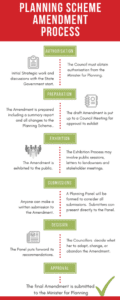24 Nov Planning Scheme Amendment Process
I often get asked about planning scheme amendments, how the process works and what the implications are for current projects.
The typical process for a significant planning scheme amendment is described below. While the process for Council driven amendments and private amendments (those facilitated by private land owners) are fairly similar I am focusing on Council driven amendments in this article. You can also read more information about planning scheme amendments from the State Government.
Amendment Process
If the Minister approves the amendment, the planning scheme is amended from that gazettal date. With most planning scheme amendments there is no transition period between the old and new planning scheme. The new planning scheme simply takes affect from that date. This has a significant implications for planning application decisions:
- Council’s assessment on a planning application is made on planning controls at the time of the decision, not the controls when the application was made. Once an Amendment is introduced, these new rules will be used in making all decisions. This can mean that something that was allowed when you lodged will no longer be allowed by the time the decision is being made.
- To try and smooth the transition from old to new, Council’s will often start making decisions based on the new, impending controls. Typically this will be when the amendment is awaiting approval with the Minister, but the Council may encourage applicants to have regard to the proposed new planning scheme much earlier to reduce the surprise affect.
Transition periods are sometimes written into the planning scheme amendment. For example the transition period within the Neighbourhood Residential Zone that allowed applications for more than two dwellings to be considered if they were lodged before the approval date of the amendment. The use of transition periods is, however, the exception rather than the rule and most planning scheme amendments will simply apply from the date they are approved. For this reason, any planning scheme amendments that impacts on the project should be carefully analysed.
Time Frame for Amendments
It is worth noting that the planning scheme amendment process outlined above is quite a lengthy one, with time measured in months between each step and the total time taken often being more than 12 months. For example, Greater Dandenong are currently undergoing an amendment to change some local policies and residential zone provisions. The Council resolved to seek authorisation to prepare the amendment on 22 June 2015 and this amendment was only recently submitted to the Minister for approval as of August this year some 14 months later. The amendment is still pending a decision from the Minister but the Council are expecting a decision this year which will mean that the total process will have been approximately 18 months.
It is also worth pointing out that the Victorian Civil and Administrative Tribunal (VCAT) are bound by the same rules as the Council when making a decision. If a planning scheme amendment is approved before a case is heard by the tribunal, the decision will be made on the new planning controls. With waiting times of up to 8 months for a hearing date, this can make it significantly harder to “beat” an amendment. VCAT will also have regard to amendments that aren’t yet approved, but are “seriously entertained”. An amendment is typically considered “seriously entertained” when it has been submitted to the Minister for approval.
Hopefully the above information will give you a good idea of how far along an Amendment is and how soon it will be completed. Planning Scheme Amendments are typically fairly slow moving events, but as they can have dramatic consequences for projects they should be watched and considered carefully.


